Python Exception Handling
1 like303 views
Python Exception Handling This is a presentation to take your skills to next level. Hope you will like our work to make programming easier for you. Feel free to contact for the online/offline batches.
1 of 21
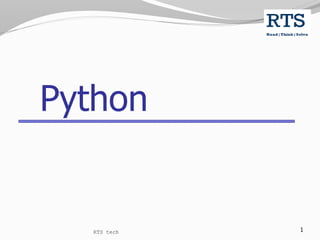
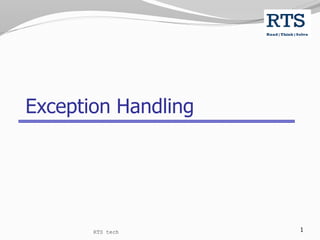
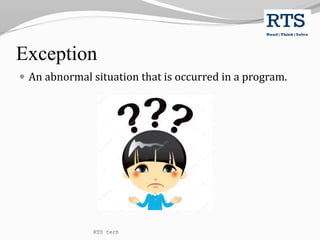


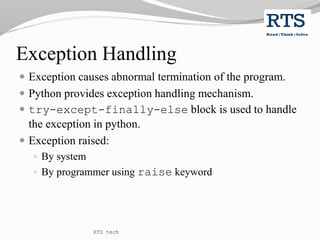
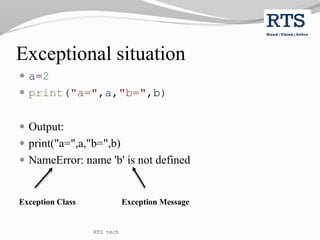

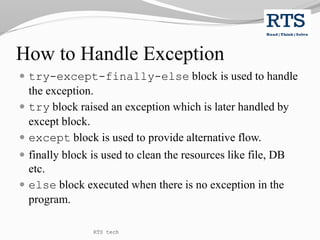

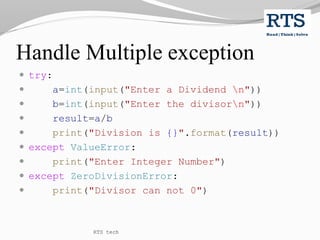
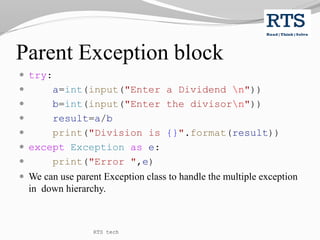


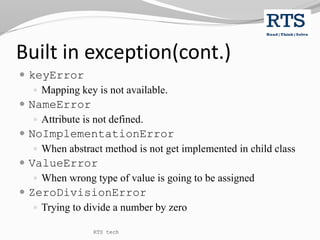
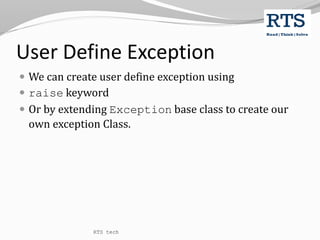
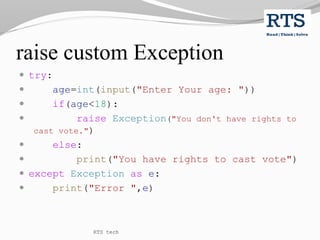
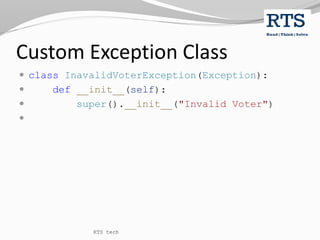



Recommended
Python-oop



Python-oopRTS Tech
╠²
Python: Object oriented programming, RTS Tech. Indore
This is a presentation to take your skills to next level. Hope you will like our work to make programming easier for you.
Feel free to contact for the online/offline batches.Exception Handling In Python | Exceptions In Python | Python Programming Tuto...



Exception Handling In Python | Exceptions In Python | Python Programming Tuto...Edureka!
╠²
** Python Certification Training: https://www.edureka.co/python-programming-certification-training **
This Edureka PPT on Exception Handling Tutorial covers all the important aspects of making use and working with Exceptions using Python. It establishes all of the concepts like explaining why we need exception handling, the process of exception handling and how to go about using it practically.
Agenda
Why need Exception Handling?
What is Exception Handling?
Process of Exception Handling
Coding with Python
Try and Except block in Python
The else clause
The finally clause
Summary
Python Tutorial Playlist: https://goo.gl/WsBpKe
Blog Series: http://bit.ly/2sqmP4s
Instagram: https://www.instagram.com/edureka_lea...
Facebook: https://www.facebook.com/edurekaIN/
Twitter: https://twitter.com/edurekain
LinkedIn: https://www.linkedin.com/company/edureka Exception handling in python



Exception handling in pythonbaabtra.com - No. 1 supplier of quality freshers
╠²
This document provides information about a mentoring program run by Baabtra-Mentoring Partner. It includes a trainee's typing speed progress over 5 weeks, with targets and achievements. It also lists 3 job applications with company names, designations, and application dates. Finally, it discusses Python exceptions handling, including try/catch blocks, built-in exception classes, raising exceptions, and error types.Python GUI Programming



Python GUI ProgrammingRTS Tech
╠²
The document discusses GUI technologies in Python. It covers Tkinter, which is the standard GUI library in Python. Tkinter can be used to create desktop applications and provides widgets like labels, buttons, entries and frames. It also discusses how to create windows, add widgets, handle events and create a simple calculator application as an example.Exceptions in python



Exceptions in pythonbaabtra.com - No. 1 supplier of quality freshers
╠²
This document provides an overview of exceptions in Python. It discusses that Python uses exceptions to communicate errors and anomalies. The try statement provides Python's exception handling mechanism and can have a try clause followed by except or finally clauses. Built-in exception classes that are subclasses of Exception include AttributeError, EnvironmentError, ImportError, LookupError, NameError, SyntaxError, and others. The document provides an example of using try, except, and finally clauses to handle exceptions occurring when connecting to a database and committing an INSERT statement. It was presented by Shameena V as part of a mentoring program through Baabtra-Mentoring Partner.Arrays In Python | Python Array Operations | Edureka



Arrays In Python | Python Array Operations | EdurekaEdureka!
╠²
** Python Certification Training: https://www.edureka.co/python **
This Edureka PPT on 'Arrays in Python' will help you establish a strong hold on all the fundamentals in the Python programming language. Below are the topics covered in this PPT:
What is an array?
Is python list same as an array?
How to create arrays in python?
Accessing array elements
Basic array operations
- Finding the length of an array
- Adding Elements
- Removing elements
- Array concatenation
- Slicing
- Looping
Python Tutorial Playlist: https://goo.gl/WsBpKe
Blog Series: http://bit.ly/2sqmP4s
Follow us to never miss an update in the future.
YouTube: https://www.youtube.com/user/edurekaIN
Instagram: https://www.instagram.com/edureka_learning/
Facebook: https://www.facebook.com/edurekaIN/
Twitter: https://twitter.com/edurekain
LinkedIn: https://www.linkedin.com/company/edureka
Date and Time Module in Python | Edureka



Date and Time Module in Python | EdurekaEdureka!
╠²
YouTube Link: https://youtu.be/mHezNgNBnuA
** Python Certification Training: https://www.edureka.co/python **
This Edureka PPT on 'Date and Time in Python' will train you to use the datetime and time modules to fetch, set and modify date and time in python.
Below are the topics covered in this PPT:
The time module
Built-in functions
Examples
The datetime module
Built-in functions
Examples
Follow us to never miss an update in the future.
YouTube: https://www.youtube.com/user/edurekaIN
Instagram: https://www.instagram.com/edureka_learning/
Facebook: https://www.facebook.com/edurekaIN/
Twitter: https://twitter.com/edurekain
LinkedIn: https://www.linkedin.com/company/edureka
Castbox: https://castbox.fm/networks/505?country=inIterarators and generators in python



Iterarators and generators in pythonSarfaraz Ghanta
╠²
Basics of Iterators and Generators,Uses of iterators and generators in python. advantage of iterators and generators. difference between generators and iterators.Python Exception Handling



Python Exception HandlingMegha V
╠²
The document discusses Python exception handling. It describes three types of errors in Python: compile time errors (syntax errors), runtime errors (exceptions), and logical errors. It explains how to handle exceptions using try, except, and finally blocks. Common built-in exceptions like ZeroDivisionError and NameError are also covered. The document concludes with user-defined exceptions and logging exceptions.Types of exceptions



Types of exceptionsmyrajendra
╠²
This document discusses types of exceptions in Java. It begins by showing the exception hierarchy with Throwable at the top, and Error and Exception as subclasses. Exception is used for exceptions that user programs should catch, while Error defines exceptions not expected to be caught. There are two types of exceptions: unchecked exceptions which do not need to be included in a method's throws list, and checked exceptions which must be included in the throws list or caught within a method. Examples of each type are provided.Python Generators



Python GeneratorsAkshar Raaj
╠²
║▌║▌▀Żs accompanying the Generators meetup for HyPy.
https://www.meetup.com/Hyderabad-Python-Meetup-Group/events/245065908/Python GUI



Python GUILusciousLarryDas
╠²
Tkinter is a standard GUI library for Python that provides a powerful object-oriented interface to the Tk GUI toolkit. It allows for the creation of GUI applications through widgets like buttons, labels, text boxes, and more. Tkinter applications start with importing the library and creating a main window with Tk(), then entering the main event loop with mainloop() to wait for and process events. Widgets can be organized and placed within the main window using geometry managers like pack(), grid(), and place(). Events can also be handled through binding Python functions to different widget events.Exceptions handling notes in JAVA



Exceptions handling notes in JAVASunil Kumar Gunasekaran
╠²
Java handles two types of exceptions - unchecked exceptions and checked exceptions. Unchecked exceptions do not need to be handled by programmers, while checked exceptions must be handled. Checked exceptions are environment or server-related issues outside a programmer's control. There are three ways to handle checked exceptions: try-catch blocks, throwing exceptions with the throw keyword, or specifying exceptions with the throws keyword in method signatures. Finally blocks are used to ensure cleanup code executes after try or catch blocks complete.Java exception handling ppt



Java exception handling pptJavabynataraJ
╠²
This document provides an overview of exception handling in Java. It discusses what exceptions are, what happens when exceptions occur, benefits of Java's exception handling framework such as separating error handling code and propagating exceptions up the call stack. It also covers catching exceptions using try-catch and finally blocks, throwing custom exceptions, the exception class hierarchy, and differences between checked and unchecked exceptions. The document concludes with a discussion of assertions.Tkinter_GUI_Programming_in_Python.pdf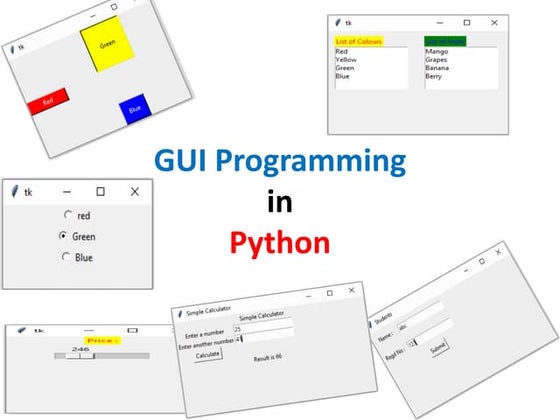



Tkinter_GUI_Programming_in_Python.pdfArielManzano3
╠²
The document provides information about GUI programming in Python using Tkinter. It discusses the various widgets available in Tkinter like Button, Checkbutton, Entry, Frame, Label, Listbox, Radiobutton, Text, and Scale. It explains how to create a basic Tkinter window and add widgets to it. Methods like pack(), grid(), and place() are described for organizing widgets. Code examples are given for each widget to demonstrate how to use them.Python decorators



Python decoratorsAlex Su
╠²
Python decorators allow functions and classes to be augmented or modified by wrapper objects. Decorators take the form of callable objects that process other callable objects like functions and classes. Decorators are applied once when a function or class is defined, making augmentation logic explicit and avoiding the need to modify call sites. Decorators can manage state information, handle multiple instances, and take arguments to customize behavior. However, decorators also introduce type changes and extra function calls that incur performance costs.How to download and install Python - lesson 2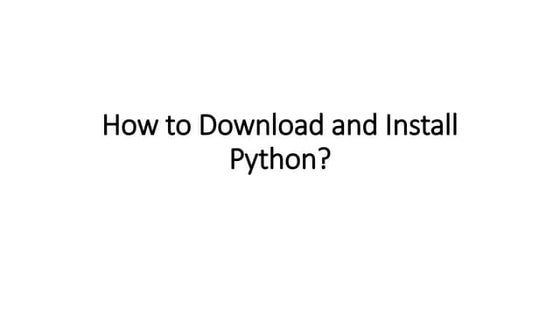



How to download and install Python - lesson 2Shohel Rana
╠²
We will follow some steps to complete the installation process of Python.
1. Download the Python installer from Python website.
2. By double clicking install it.
3. Set the path for Python
4. Check Python is working very well.
5. If you missed the path setting for Python, then uninstall it and re install Python.Python╠²Data Types,numbers.pptx



Python╠²Data Types,numbers.pptxadityakumawat625
╠²
This document discusses Python's built-in data types. It covers the three numeric types - integers, floats, and complexes - and how to create variables of each type by assigning values. It also explains how to check the data type of a variable and convert between types using functions like int(), float(), and complex(). The document provides examples of each data type, type checking, and type conversion.Python Functions Tutorial | Working With Functions In Python | Python Trainin...



Python Functions Tutorial | Working With Functions In Python | Python Trainin...Edureka!
╠²
** Python Certification Training: https://www.edureka.co/python **
This Edureka PPT on Python Functions tutorial covers all the important aspects of functions in Python right from the introduction to what functions are, all the way till checking out the major functions and using the code-first approach to understand them better.
Agenda
Why use Functions?
What are the Functions?
Types of Python Functions
Built-in Functions in Python
User-defined Functions in Python
Python Lambda Function
Conclusion
Python Tutorial Playlist: https://goo.gl/WsBpKe
Blog Series: http://bit.ly/2sqmP4s
Follow us to never miss an update in the future.
Instagram: https://www.instagram.com/edureka_learning/
Facebook: https://www.facebook.com/edurekaIN/
Twitter: https://twitter.com/edurekain
LinkedIn: https://www.linkedin.com/company/edurekaChapter 07 inheritance



Chapter 07 inheritancePraveen M Jigajinni
╠²
1. Inheritance is a mechanism where a new class is derived from an existing class, known as the base or parent class. The derived class inherits properties and methods from the parent class.
2. There are 5 types of inheritance: single, multilevel, multiple, hierarchical, and hybrid. Multiple inheritance allows a class to inherit from more than one parent class.
3. Overriding allows a subclass to replace or extend a method defined in the parent class, while still calling the parent method using the super() function or parent class name. This allows the subclass to provide a specific implementation of a method.Python collections



Python collectionsManusha Dilan
╠²
This document provides an overview of Python collections including strings, bytes, lists, tuples, dictionaries, sets, and ranges. It discusses how to create, access, modify, iterate through, and perform common operations on each collection type. For each collection, it provides examples of basic usage and built-in methods. The document is intended as a reference for working with the main collection data types in Python.Fundamentals of Python Programming



Fundamentals of Python ProgrammingKamal Acharya
╠²
The document provides an introduction to Python programming including its features, uses, history, and installation process. Some key points covered include:
- Python is an interpreted, object-oriented programming language that is used for web development, scientific computing, and desktop applications.
- It was created by Guido van Rossum in 1991 and named after the Monty Python comedy group.
- To install Python on Windows, users download the latest version from python.org and run the installer, which also installs the IDLE development environment.
- The document then covers basic Python concepts like variables, data types, operators, and input/output functions.Python OOPs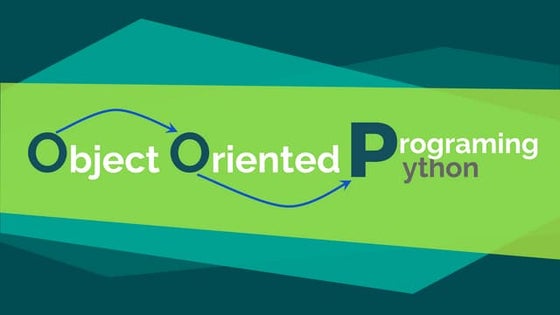



Python OOPsBinay Kumar Ray
╠²
This document provides an introduction to object oriented programming in Python. It discusses key OOP concepts like classes, methods, encapsulation, abstraction, inheritance, polymorphism, and more. Each concept is explained in 1-2 paragraphs with examples provided in Python code snippets. The document is presented as a slideshow that is meant to be shared and provide instruction on OOP in Python.Python my sql database connection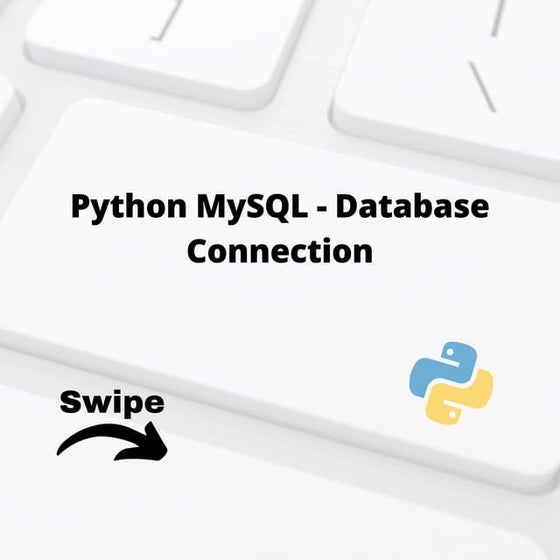



Python my sql database connectionLearnbay Datascience
╠²
This presentation educates you about Python MySQL - Database Connection, Python MySQL - Database Connection, Establishing connection with MySQL using python with sample program.
For more topics stay tuned with Learnbay.
Strings in Python



Strings in PythonAmisha Narsingani
╠²
Strings in Python can be created using single quotes, double quotes, or triple quotes. Strings are immutable and indexing allows accessing individual characters. Strings can be sliced to extract substrings. The + operator is used for concatenation and * operator repeats strings. The split method returns a list of substrings split by a delimiter and join method concatenates strings with a delimiter.Python programming : Files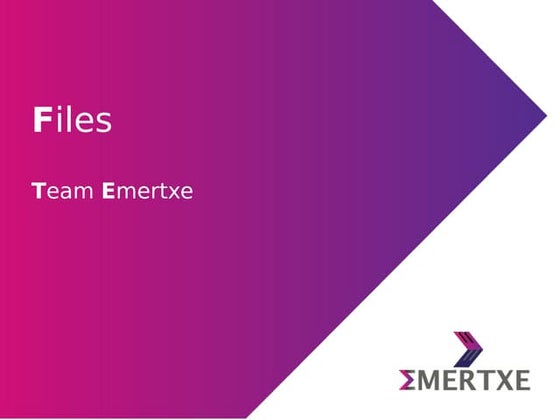



Python programming : FilesEmertxe Information Technologies Pvt Ltd
╠²
The document discusses files in Python. It defines a file as an object that stores data, information, settings or commands used with a computer program. There are two main types of files - text files which store data as strings, and binary files which store data as bytes. The document outlines how to open, read, write, append, close and manipulate files in Python using functions like open(), read(), write(), close() etc. It also discusses pickling and unpickling objects to binary files for serialization. Finally, it covers working with directories and running other programs from Python.Threads in python



Threads in pythonbaabtra.com - No. 1 supplier of quality freshers
╠²
This document provides a summary of threads in Python. It begins by defining what a thread is and how it allows for multitasking by time-division multiplexing the processor between threads. It then discusses how to start new threads in Python using the thread and threading modules, including examples. It also covers how to create threads that subclass the Thread class and how to synchronize threads using locks.Python functions



Python functionsProf. Dr. K. Adisesha
╠²
Functions allow programmers to organize code into reusable blocks. A function is defined using the def keyword and can accept parameters. The body of a function contains a set of statements that run when the function is called. Functions can return values and allow code to be reused, reducing errors and improving readability. Parameters allow information to be passed into functions, while return values allow functions to provide results.Python Unit II.pptx



Python Unit II.pptxsarthakgithub
╠²
Types of errors include syntax errors, logical errors, and runtime errors. Exceptions are errors that occur during program execution. When an exception occurs, Python generates an exception object that can be handled to avoid crashing the program. Exceptions allow errors to be handled gracefully. The try and except blocks are used to catch and handle exceptions. Python has a hierarchy of built-in exceptions like ZeroDivisionError, NameError, and IOError.Exception Handling in python programming.pptx



Exception Handling in python programming.pptxshririshsri
╠²
Here...this ppt shows the programming language named "python".In python,file 'exception handing' and their examples & exercises are given.it gives the clear idea of the python exception.More Related Content
What's hot (20)
Python Exception Handling



Python Exception HandlingMegha V
╠²
The document discusses Python exception handling. It describes three types of errors in Python: compile time errors (syntax errors), runtime errors (exceptions), and logical errors. It explains how to handle exceptions using try, except, and finally blocks. Common built-in exceptions like ZeroDivisionError and NameError are also covered. The document concludes with user-defined exceptions and logging exceptions.Types of exceptions



Types of exceptionsmyrajendra
╠²
This document discusses types of exceptions in Java. It begins by showing the exception hierarchy with Throwable at the top, and Error and Exception as subclasses. Exception is used for exceptions that user programs should catch, while Error defines exceptions not expected to be caught. There are two types of exceptions: unchecked exceptions which do not need to be included in a method's throws list, and checked exceptions which must be included in the throws list or caught within a method. Examples of each type are provided.Python Generators



Python GeneratorsAkshar Raaj
╠²
║▌║▌▀Żs accompanying the Generators meetup for HyPy.
https://www.meetup.com/Hyderabad-Python-Meetup-Group/events/245065908/Python GUI



Python GUILusciousLarryDas
╠²
Tkinter is a standard GUI library for Python that provides a powerful object-oriented interface to the Tk GUI toolkit. It allows for the creation of GUI applications through widgets like buttons, labels, text boxes, and more. Tkinter applications start with importing the library and creating a main window with Tk(), then entering the main event loop with mainloop() to wait for and process events. Widgets can be organized and placed within the main window using geometry managers like pack(), grid(), and place(). Events can also be handled through binding Python functions to different widget events.Exceptions handling notes in JAVA



Exceptions handling notes in JAVASunil Kumar Gunasekaran
╠²
Java handles two types of exceptions - unchecked exceptions and checked exceptions. Unchecked exceptions do not need to be handled by programmers, while checked exceptions must be handled. Checked exceptions are environment or server-related issues outside a programmer's control. There are three ways to handle checked exceptions: try-catch blocks, throwing exceptions with the throw keyword, or specifying exceptions with the throws keyword in method signatures. Finally blocks are used to ensure cleanup code executes after try or catch blocks complete.Java exception handling ppt



Java exception handling pptJavabynataraJ
╠²
This document provides an overview of exception handling in Java. It discusses what exceptions are, what happens when exceptions occur, benefits of Java's exception handling framework such as separating error handling code and propagating exceptions up the call stack. It also covers catching exceptions using try-catch and finally blocks, throwing custom exceptions, the exception class hierarchy, and differences between checked and unchecked exceptions. The document concludes with a discussion of assertions.Tkinter_GUI_Programming_in_Python.pdf



Tkinter_GUI_Programming_in_Python.pdfArielManzano3
╠²
The document provides information about GUI programming in Python using Tkinter. It discusses the various widgets available in Tkinter like Button, Checkbutton, Entry, Frame, Label, Listbox, Radiobutton, Text, and Scale. It explains how to create a basic Tkinter window and add widgets to it. Methods like pack(), grid(), and place() are described for organizing widgets. Code examples are given for each widget to demonstrate how to use them.Python decorators



Python decoratorsAlex Su
╠²
Python decorators allow functions and classes to be augmented or modified by wrapper objects. Decorators take the form of callable objects that process other callable objects like functions and classes. Decorators are applied once when a function or class is defined, making augmentation logic explicit and avoiding the need to modify call sites. Decorators can manage state information, handle multiple instances, and take arguments to customize behavior. However, decorators also introduce type changes and extra function calls that incur performance costs.How to download and install Python - lesson 2



How to download and install Python - lesson 2Shohel Rana
╠²
We will follow some steps to complete the installation process of Python.
1. Download the Python installer from Python website.
2. By double clicking install it.
3. Set the path for Python
4. Check Python is working very well.
5. If you missed the path setting for Python, then uninstall it and re install Python.Python╠²Data Types,numbers.pptx



Python╠²Data Types,numbers.pptxadityakumawat625
╠²
This document discusses Python's built-in data types. It covers the three numeric types - integers, floats, and complexes - and how to create variables of each type by assigning values. It also explains how to check the data type of a variable and convert between types using functions like int(), float(), and complex(). The document provides examples of each data type, type checking, and type conversion.Python Functions Tutorial | Working With Functions In Python | Python Trainin...



Python Functions Tutorial | Working With Functions In Python | Python Trainin...Edureka!
╠²
** Python Certification Training: https://www.edureka.co/python **
This Edureka PPT on Python Functions tutorial covers all the important aspects of functions in Python right from the introduction to what functions are, all the way till checking out the major functions and using the code-first approach to understand them better.
Agenda
Why use Functions?
What are the Functions?
Types of Python Functions
Built-in Functions in Python
User-defined Functions in Python
Python Lambda Function
Conclusion
Python Tutorial Playlist: https://goo.gl/WsBpKe
Blog Series: http://bit.ly/2sqmP4s
Follow us to never miss an update in the future.
Instagram: https://www.instagram.com/edureka_learning/
Facebook: https://www.facebook.com/edurekaIN/
Twitter: https://twitter.com/edurekain
LinkedIn: https://www.linkedin.com/company/edurekaChapter 07 inheritance



Chapter 07 inheritancePraveen M Jigajinni
╠²
1. Inheritance is a mechanism where a new class is derived from an existing class, known as the base or parent class. The derived class inherits properties and methods from the parent class.
2. There are 5 types of inheritance: single, multilevel, multiple, hierarchical, and hybrid. Multiple inheritance allows a class to inherit from more than one parent class.
3. Overriding allows a subclass to replace or extend a method defined in the parent class, while still calling the parent method using the super() function or parent class name. This allows the subclass to provide a specific implementation of a method.Python collections



Python collectionsManusha Dilan
╠²
This document provides an overview of Python collections including strings, bytes, lists, tuples, dictionaries, sets, and ranges. It discusses how to create, access, modify, iterate through, and perform common operations on each collection type. For each collection, it provides examples of basic usage and built-in methods. The document is intended as a reference for working with the main collection data types in Python.Fundamentals of Python Programming



Fundamentals of Python ProgrammingKamal Acharya
╠²
The document provides an introduction to Python programming including its features, uses, history, and installation process. Some key points covered include:
- Python is an interpreted, object-oriented programming language that is used for web development, scientific computing, and desktop applications.
- It was created by Guido van Rossum in 1991 and named after the Monty Python comedy group.
- To install Python on Windows, users download the latest version from python.org and run the installer, which also installs the IDLE development environment.
- The document then covers basic Python concepts like variables, data types, operators, and input/output functions.Python OOPs



Python OOPsBinay Kumar Ray
╠²
This document provides an introduction to object oriented programming in Python. It discusses key OOP concepts like classes, methods, encapsulation, abstraction, inheritance, polymorphism, and more. Each concept is explained in 1-2 paragraphs with examples provided in Python code snippets. The document is presented as a slideshow that is meant to be shared and provide instruction on OOP in Python.Python my sql database connection



Python my sql database connectionLearnbay Datascience
╠²
This presentation educates you about Python MySQL - Database Connection, Python MySQL - Database Connection, Establishing connection with MySQL using python with sample program.
For more topics stay tuned with Learnbay.
Strings in Python



Strings in PythonAmisha Narsingani
╠²
Strings in Python can be created using single quotes, double quotes, or triple quotes. Strings are immutable and indexing allows accessing individual characters. Strings can be sliced to extract substrings. The + operator is used for concatenation and * operator repeats strings. The split method returns a list of substrings split by a delimiter and join method concatenates strings with a delimiter.Python programming : Files



Python programming : FilesEmertxe Information Technologies Pvt Ltd
╠²
The document discusses files in Python. It defines a file as an object that stores data, information, settings or commands used with a computer program. There are two main types of files - text files which store data as strings, and binary files which store data as bytes. The document outlines how to open, read, write, append, close and manipulate files in Python using functions like open(), read(), write(), close() etc. It also discusses pickling and unpickling objects to binary files for serialization. Finally, it covers working with directories and running other programs from Python.Threads in python



Threads in pythonbaabtra.com - No. 1 supplier of quality freshers
╠²
This document provides a summary of threads in Python. It begins by defining what a thread is and how it allows for multitasking by time-division multiplexing the processor between threads. It then discusses how to start new threads in Python using the thread and threading modules, including examples. It also covers how to create threads that subclass the Thread class and how to synchronize threads using locks.Python functions



Python functionsProf. Dr. K. Adisesha
╠²
Functions allow programmers to organize code into reusable blocks. A function is defined using the def keyword and can accept parameters. The body of a function contains a set of statements that run when the function is called. Functions can return values and allow code to be reused, reducing errors and improving readability. Parameters allow information to be passed into functions, while return values allow functions to provide results.Similar to Python Exception Handling (20)
Python Unit II.pptx



Python Unit II.pptxsarthakgithub
╠²
Types of errors include syntax errors, logical errors, and runtime errors. Exceptions are errors that occur during program execution. When an exception occurs, Python generates an exception object that can be handled to avoid crashing the program. Exceptions allow errors to be handled gracefully. The try and except blocks are used to catch and handle exceptions. Python has a hierarchy of built-in exceptions like ZeroDivisionError, NameError, and IOError.Exception Handling in python programming.pptx



Exception Handling in python programming.pptxshririshsri
╠²
Here...this ppt shows the programming language named "python".In python,file 'exception handing' and their examples & exercises are given.it gives the clear idea of the python exception.Nalinee java



Nalinee javaNalinee Choudhary
╠²
There are three main ways to create and start a new thread in Java: 1) by extending the Thread class, 2) by implementing the Runnable interface, and 3) by using an anonymous class that implements Runnable. The Thread scheduler determines which thread will execute first based on priority and other factors. The main thread lifecycle states are new, runnable, running, and dead. Methods like yield(), join(), setPriority(), etc. allow controlling thread behavior.Exception handling



Exception handlingRaja Sekhar
╠²
JAVA EXCEPTION HANDLING
N.V.Raja Sekhar Reddy
www.technolamp.co.in
Want more interesting...
Watch and Like us @ https://www.facebook.com/Technolamp.co.in
subscribe videos @ http://www.youtube.com/user/nvrajasekharException handlingpdf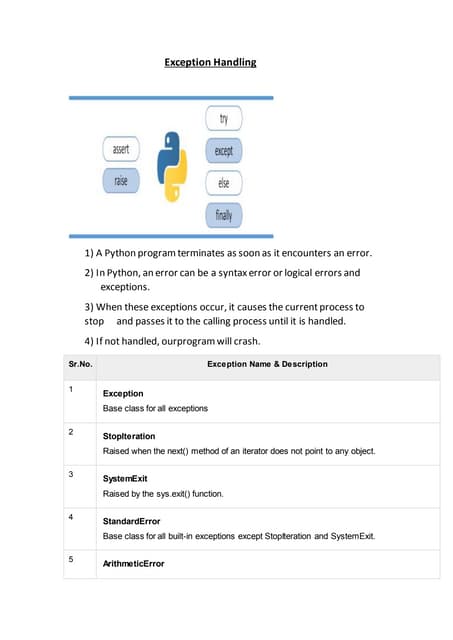



Exception handlingpdfgandra jeeshitha
╠²
Exception handling in Python allows programs to handle errors and exceptions gracefully to prevent crashes. There are various types of exceptions that can occur. The try and except blocks allow code to execute normally or handle exceptions. Finally blocks let code execute regardless of exceptions. Raise statements can be used to explicitly raise exceptions if conditions occur. Assertions validate conditions and raise exceptions if validation fails. Exceptions allow errors to be detected and addressed to improve program reliability.12. Exception Handling 



12. Exception Handling Intro C# Book
╠²
This document discusses exception handling in .NET. It defines exceptions as objects that are thrown when errors or unexpected events occur during program execution. Exceptions allow errors to be handled at multiple levels through try-catch blocks. The core exception class is System.Exception, which other custom exceptions inherit from. Exceptions can be thrown manually with throw or occur automatically from errors. Finally blocks ensure code is always executed even if an exception is thrown.C# Exceptions Handling 



C# Exceptions Handling sharqiyem
╠²
The document discusses exceptions handling in .NET. It defines exceptions as objects that deliver a powerful mechanism for centralized handling of errors and unusual events. It describes how exceptions can be handled using try-catch blocks, and how finally blocks ensure code execution regardless of exceptions. It also covers the Exception class hierarchy, throwing exceptions with the throw keyword, and best practices like ordering catch blocks and avoiding exceptions for normal flow control.12 Exceptions handling



12 Exceptions handlingmaznabili
╠²
Exceptions allow errors during program execution to be processed in a centralized manner rather than returning error codes from each function. The .NET Framework implements exceptions using the object-oriented exception model. Exceptions are handled using try-catch blocks and all exceptions inherit from the System.Exception class. Exceptions can be thrown manually using the throw keyword and will propagate up the call stack until caught by a matching catch block.Python Lecture 7



Python Lecture 7Inzamam Baig
╠²
This document discusses Python errors and exceptions. It explains that there are two types of errors in Python: syntax errors, which occur due to incorrect syntax, and exceptions (also called logical errors), which occur during runtime. It provides examples of common exceptions like ZeroDivisionError, FileNotFoundError, and ImportError. The document also discusses how to handle exceptions using try/except blocks in Python and how to raise custom exceptions. Finally, it covers some advanced exception handling techniques like specifying multiple exceptions, using else and finally blocks, and raising exceptions manually.Python Programming Essentials - M21 - Exception Handling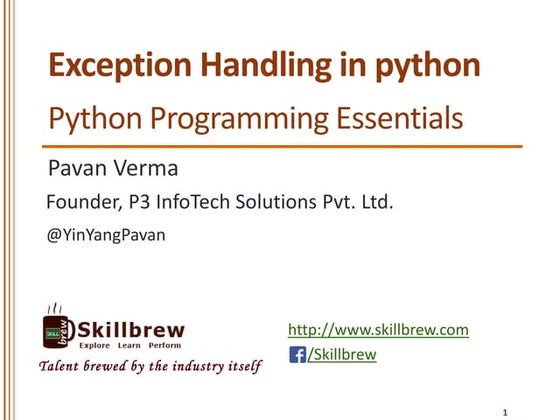



Python Programming Essentials - M21 - Exception HandlingP3 InfoTech Solutions Pvt. Ltd.
╠²
This document discusses exception handling in Python. It explains that exceptions are errors that occur during program execution and can be handled using try, except, and raise keywords. The document covers throwing exceptions, catching exceptions using try/except blocks, propagating exceptions, using try/except/else and try/except/finally, and some common built-in Python exceptions. It also provides an example of defining a custom exception class.java exception.pptx



java exception.pptxSukhpreetSingh519414
╠²
This document provides an overview of exception handling in Java. It defines what exceptions are, which are errors that disrupt normal program flow. There are three main types of exceptions: checked exceptions that must be declared, unchecked exceptions that do not need to be declared, and errors. The try-catch block is used to handle exceptions, with catch blocks specifying the exception types to handle. Finally blocks will execute regardless of whether an exception occurred or not and are used for cleanup code. Custom exceptions can also be created by extending the Exception class.Java c─ān bß║Żn - Chapter8



Java c─ān bß║Żn - Chapter8Vince Vo
╠²
This chapter discusses exceptions and assertions in Java. The key points are:
1. Exceptions represent error conditions and allow for graceful handling of problems rather than program crashes. Exceptions can be caught and handled using try-catch blocks.
2. Checked exceptions must be caught or propagated using throws, while unchecked exceptions are for runtime errors and catching is optional.
3. Assertions use the assert statement to check for expected conditions and throw errors if false, helping find bugs. Assertions must be enabled during compilation and execution.Chapter 8 - Exceptions and Assertions Edit summary



Chapter 8 - Exceptions and Assertions Edit summaryEduardo Bergavera
╠²
This chapter discusses exceptions and assertions in Java. The key points are:
1. Exceptions represent error conditions and allow for graceful handling of errors rather than program crashes. Exceptions can be caught using try-catch blocks.
2. Checked exceptions must be caught or declared in a method, while unchecked exceptions do not require handling.
3. Assertions allow checking for expected conditions and throwing errors if conditions are not met. Assertions are enabled during compilation and execution.Unit iii



Unit iiisnehaarao19
╠²
The document introduces C++ templates and exceptions. It discusses three approaches to functions that implement identical tasks for different data types: the naïve approach with unique function names, function overloading with the same name, and function templates where the compiler generates individual functions. It also covers class templates where the compiler generates distinct class types, and how to instantiate class and function templates by substituting the template argument. Finally, it discusses exception handling in C++ using try, throw, catch blocks to handle errors and exceptions thrown during program execution.Error and exception in python



Error and exception in pythonjunnubabu
╠²
Errors in Python programs are either syntax errors or exceptions. Syntax errors occur when the code has invalid syntax and exceptions occur when valid code causes an error at runtime. Exceptions can be handled by using try and except blocks. Users can also define their own exceptions by creating exception classes that inherit from the built-in Exception class. The finally block gets executed whether or not an exception was raised and is used to define clean-up actions. The with statement is also used to ensure objects are cleaned up properly after use.UNIT III (2).ppt



UNIT III (2).pptVGaneshKarthikeyan
╠²
C++ templates and exceptions allow for more robust and reusable code. Templates allow functions and classes to work with different data types by using placeholder types that are substituted at compile-time. This avoids duplicating code and reduces errors. Exceptions provide a mechanism to handle errors and unexpected events in code through throwing and catching exception objects. Exceptions allow code to exit a block and transfer control to dedicated error handling code. Together, templates and exceptions make C++ code more flexible, reusable and fault-tolerant.Recently uploaded (20)
Requirements Engineering for Secure Software



Requirements Engineering for Secure SoftwareDr Sarika Jadhav
╠²
Security requirements are often treated as generic lists of features, neglecting system-specific needs and the attacker's perspective. A systematic approach to security requirements engineering is crucial to avoid this problem.
Requirements engineering defects can cost 10 to 200 times more to correct once the system is operational. Software development takes place in a dynamic environment, causing requirements to constantly change.
Software security: Security a Software Issue



Software security: Security a Software IssueDr Sarika Jadhav
╠²
Software is often designed with security as an afterthought, leading to vulnerabilities that can be exploited by attackers. This has become a critical issue as our reliance on software continues to grow.
Increasing number and sophistication of attacks (CERT vulnerability reports rising).
Software security is the practice of protecting applications from unauthorized access, modification, and destruction.
Secure software development practices.
Executives (E)
Project Managers (M)
Technical Leaders (L)
UHV UNIT-5 IMPLICATIONS OF THE ABOVE HOLISTIC UNDERSTANDING OF HARMONY ON ...



UHV UNIT-5 IMPLICATIONS OF THE ABOVE HOLISTIC UNDERSTANDING OF HARMONY ON ...ariomthermal2031
╠²
IMPLICATIONS OF THE ABOVE HOLISTIC UNDERSTANDING OF HARMONY ON PROFESSIONAL ETHICS Lecture 16 - 17 - NonTraditional Machining Presentation.ppt



Lecture 16 - 17 - NonTraditional Machining Presentation.pptINSTITUTE OF ENGINEERING /BKC
╠²
It describes evolution of new processesFIRST Tech Challenge/Robotics: Scouting out the competition



FIRST Tech Challenge/Robotics: Scouting out the competitionFTC Team 23014
╠²
Learn how to effectively scout teams in preparation for your next competitionKtor - Definizioni di Path, Integrazioni, Plugin e build fino al rilascio



Ktor - Definizioni di Path, Integrazioni, Plugin e build fino al rilascioinfogdgmi
╠²
Tra i vari framework backend basati sulla JVM, uno in particolare, con il passare del tempo, ha saputo ritagliarsi il suo spazio: era Ktor (figlio di Kmer).
In questo talk faremo un tour di Ktor,
dalla sua parte backend: Definizioni di Path, Integrazioni, Plugin e build fino al rilascio (e qualche chicca),
fino alla sua controparte client e qualche sua integrazioneScalling Rails: The Journey to 200M Notifications



Scalling Rails: The Journey to 200M NotificationsGustavo Araujo
╠²
Talk presented at Tropical On Rails.Introduction to 3D Printing Technology.pptx



Introduction to 3D Printing Technology.pptxpprakash21252
╠²
Welcome to our presentation on 3D printing technology, where we explore the transformative power of this innovative manufacturing process. Also known as additive manufacturing, 3D printing has been gaining momentum in recent years, and its potential to revolutionize industries is vast.
In this presentation, we delve into the world of 3D printing, discussing its history, principles, and applications. We examine the various types of 3D printing technologies, including Fused Deposition Modeling (FDM), Stereolithography (SLA), and Selective Laser Sintering (SLS). We also explore the advantages and limitations of 3D printing, including its ability to create complex geometries, reduce material waste, and increase product customization.
One of the most significant impacts of 3D printing is its potential to transform industries. We discuss the applications of 3D printing in various sectors, including aerospace, automotive, healthcare, and consumer products. We examine case studies of companies that have successfully implemented 3D printing, such as Boeing, BMW, and Procter & Gamble.
The presentation also explores the future of 3D printing, including emerging trends and technologies. We discuss the potential of 3D printing to disrupt traditional supply chains and create new business models. We also examine the challenges and limitations of 3D printing, including the need for standardization, regulation, and education.
This presentation is ideal for anyone interested in learning about 3D printing technology, including students, researchers, entrepreneurs, and industry professionals. Whether you are looking to gain a basic understanding of 3D printing or seeking to explore its applications in various industries, this presentation is a valuable resource.
271094912XOULFHKBXRCVHBJKFG KMXCG HJKLMRTVBHNJMXRCVBHUINJ



271094912XOULFHKBXRCVHBJKFG KMXCG HJKLMRTVBHNJMXRCVBHUINJQualityManager48
╠²
GYBOIY GUHNPMFXCJVHBKMYUBJMastering Secure Login Mechanisms for React Apps.pdf



Mastering Secure Login Mechanisms for React Apps.pdfBrion Mario
╠²
How to securely add login to any React applicationWhy the Engineering Model is Key to Successful Projects



Why the Engineering Model is Key to Successful ProjectsMaadhu Creatives-Model Making Company
╠²
In this PDF document, the importance of engineering models in successful project execution is discussed. It explains how these models enhance visualization, planning, and communication. Engineering models help identify potential issues early, reducing risks and costs. Ultimately, they improve collaboration and client satisfaction by providing a clear representation of the project.NBA Criteria TIER I and TIER II Comparison



NBA Criteria TIER I and TIER II ComparisonDr INBAMALAR T M
╠²
Document Preparation for NBA
Self Assessment Report (SAR) Tier I Formats
Floating Offshore Wind in the Celtic Sea



Floating Offshore Wind in the Celtic Seapermagoveu
╠²
Floating offshore wind (FLOW) governance arrangements in the Celtic Sea case are changing and innovating in response to different drivers including domestic political priorities (e.g. net-zero, decarbonization, economic growth) and external shocks that emphasize the need for energy security (e.g. the war in Ukraine).
To date, the rules of the game that guide floating wind in the UK have evolved organically rather than being designed with intent, which has created policy incoherence and fragmented governance arrangements. Despite this fragmentation, the UK has a well-established offshore wind sector and is positioning itself to become a global leader in floating wind.
Marine governance arrangements are in a state of flux as new actors, resources, and rules of the game are being introduced to deliver on this aspiration. However, the absence of a clear roadmap to deliver on ambitious floating wind targets by 2030 creates uncertainty for investors, reduces the likelihood that a new floating wind sector will deliver economic and social value to the UK, and risks further misalignment between climate and nature goals.UHV UNIT-3 HARMONY IN THE FAMILY AND SOCIETY.pptx



UHV UNIT-3 HARMONY IN THE FAMILY AND SOCIETY.pptxariomthermal2031
╠²
HARMONY IN THE FAMILY AND SOCIETY Protecting Secrets in Transparent Systems



Protecting Secrets in Transparent SystemsLucaBarbaro3
╠²
Invited talk for the Theories in Information Systems seminar-series course at the Utrecht UniversityPython Exception Handling
- 3. Exception ’éŚ An abnormal situation that is occurred in a program. RTS tech
- 4. Exception Hierarchy RTS tech BaseException Exception RuntimError ImportError ArithmeticError ŌĆ” ZeroDivisionError NoImplementationError ModuleNotFoundError ŌĆ” ŌĆ” ŌĆ”
- 5. Exception handling Exception Handling Exception Raised. RTS tech
- 6. Exception Handling ’éŚ Exception causes abnormal termination of the program. ’éŚ Python provides exception handling mechanism. ’éŚ try-except-finally-else block is used to handle the exception in python. ’éŚ Exception raised: ’éŚ By system ’éŚ By programmer using raise keyword RTS tech
- 7. Exceptional situation ’éŚ a=2 ’éŚ print("a=",a,"b=",b) ’éŚ Output: ’éŚ print("a=",a,"b=",b) ’éŚ NameError: name 'b' is not defined RTS tech Exception Class Exception Message
- 8. Handle exception ’éŚ a=2 ’éŚ try: ’éŚ print("a=",a,"b=",b) ’éŚ except NameError: ’éŚ print("check you variable Declration") ’éŚ ’éŚ Exception Handling RTS tech Exception Raised
- 9. How to Handle Exception ’éŚ try-except-finally-else block is used to handle the exception. ’éŚ try block raised an exception which is later handled by except block. ’éŚ except block is used to provide alternative flow. ’éŚ finally block is used to clean the resources like file, DB etc. ’éŚ else block executed when there is no exception in the program. RTS tech
- 10. How to get exception Message ’éŚ a=2 ’éŚ try: ’éŚ print("a=",a,"b=",b) ’éŚ except NameError as e: ’éŚ print(ŌĆ£Error:",e) RTS tech
- 11. Handle Multiple exception ’éŚ try: ’éŚ a=int(input("Enter a Dividend n")) ’éŚ b=int(input("Enter the divisorn")) ’éŚ result=a/b ’éŚ print("Division is {}".format(result)) ’éŚ except ValueError: ’éŚ print("Enter Integer Number") ’éŚ except ZeroDivisionError: ’éŚ print("Divisor can not 0") RTS tech
- 12. Parent Exception block ’éŚ try: ’éŚ a=int(input("Enter a Dividend n")) ’éŚ b=int(input("Enter the divisorn")) ’éŚ result=a/b ’éŚ print("Division is {}".format(result)) ’éŚ except Exception as e: ’éŚ print("Error ",e) ’éŚ We can use parent Exception class to handle the multiple exception in down hierarchy. RTS tech
- 13. try-except-else-finally ’éŚ try: ’éŚ a=int(input("Enter a Dividend n")) ’éŚ b=int(input("Enter the divisorn")) ’éŚ result=a/b ’éŚ except ZeroDivisionError: ’éŚ print("Divisor can not 0") ’éŚ else: ’éŚ print("Division is {}".format(result)) ’éŚ finally: ’éŚ print("I used for cleanup Task") ’éŚ print("I always executed either exception is raised or not in try block") RTS tech
- 14. Built in Exception ’éŚ AttributeError ’éŚ Fail to reference an assignment to a variable. ’éŚ EOFError ’éŚ Reading beyond the file length ’éŚ ImportError ’éŚ not able to import function from module ’éŚ ModuleNotFoundError ’éŚ Module name is not available. ’éŚ IndexError ’éŚ Beyond the index we are trying to access the element from array, list, string etc. RTS tech
- 15. Built in exception(cont.) ’éŚ keyError ’éŚ Mapping key is not available. ’éŚ NameError ’éŚ Attribute is not defined. ’éŚ NoImplementationError ’éŚ When abstract method is not get implemented in child class ’éŚ ValueError ’éŚ When wrong type of value is going to be assigned ’éŚ ZeroDivisionError ’éŚ Trying to divide a number by zero RTS tech
- 16. User Define Exception ’éŚ We can create user define exception using ’éŚ raise keyword ’éŚ Or by extending Exception base class to create our own exception Class. RTS tech
- 17. raise custom Exception ’éŚ try: ’éŚ age=int(input("Enter Your age: ")) ’éŚ if(age<18): ’éŚ raise Exception("You don't have rights to cast vote.") ’éŚ else: ’éŚ print("You have rights to cast vote") ’éŚ except Exception as e: ’éŚ print("Error ",e) RTS tech
- 18. Custom Exception Class ’éŚ class InavalidVoterException(Exception): ’éŚ def __init__(self): ’éŚ super().__init__("Invalid Voter") ’éŚ RTS tech
- 19. Test Custom Exception ’éŚ from customException import InavalidVoterException ’éŚ try: ’éŚ age=int(input("Enter Your age: ")) ’éŚ if(age<18): ’éŚ raise InavalidVoterException() ’éŚ else: ’éŚ print("You have rights to cast vote") ’éŚ except InavalidVoterException as e: ’éŚ print("Error ",e) RTS tech
- 20. Disclaimer ’éŚ This is a educational Presentation to make programming easier. ’éŚ We have used images of different URLs to make presentation better. ’éŚ We respect the work of the owners of the URLs. RTS tech
- 21. Thank You! RTS Tech. :rtstech30@gmail.com :+91 8818887087








